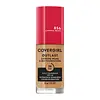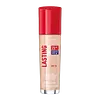Covergirl Outlast Extreme Wear 3-In-1 Foundation Versus Rimmel London Lasting Finish 25Hr Foundation SPF 20
What's inside
What's inside
 Key Ingredients
Key Ingredients

 Benefits
Benefits

 Concerns
Concerns

 Ingredients Side-by-side
Ingredients Side-by-side

Ethylhexyl Methoxycinnamate 3%
UV AbsorberCyclopentasiloxane
EmollientWater
Skin ConditioningTalc
AbrasiveButylene Glycol
HumectantCetyl PEG/PPG-10/1 Dimethicone
EmulsifyingAcrylates Crosspolymer
AbsorbentTrimethylsiloxysilicate
EmollientCetearyl Ethylhexanoate
EmollientDimethicone/Vinyl Dimethicone Crosspolymer
Skin ConditioningMagnesium Sulfate
Bis-PEG/PPG-14/14 Dimethicone
EmollientAmmonium Acrylates Copolymer
Tribehenin
EmollientDisteardimonium Hectorite
StabilisingLaureth-7
EmulsifyingLecithin
EmollientTriethoxycaprylylsilane
Phenoxyethanol
PreservativeTrihydroxystearin
Skin ConditioningChlorphenesin
AntimicrobialPropylene Carbonate
SolventAlcohol Denat.
AntimicrobialDimethiconol
EmollientXanthan Gum
EmulsifyingGlycerin
HumectantDisodium EDTA
Tocopheryl Acetate
AntioxidantDisodium Deceth-6 Sulfosuccinate
CleansingLaureth-30
CleansingSodium PCA
HumectantUrea
BufferingSodium Dehydroacetate
PreservativeTrehalose
HumectantHexylene Glycol
EmulsifyingPolyquaternium-51
Skin ConditioningBHT
AntioxidantCaprylyl Glycol
EmollientTriacetin
AntimicrobialSodium Hyaluronate
HumectantPentaerythrityl Tetra-Di-T-Butyl Hydroxyhydrocinnamate
AntioxidantCI 77891
Cosmetic ColorantIron Oxides
Ethylhexyl Methoxycinnamate 3%, Cyclopentasiloxane, Water, Talc, Butylene Glycol, Cetyl PEG/PPG-10/1 Dimethicone, Acrylates Crosspolymer, Trimethylsiloxysilicate, Cetearyl Ethylhexanoate, Dimethicone/Vinyl Dimethicone Crosspolymer, Magnesium Sulfate, Bis-PEG/PPG-14/14 Dimethicone, Ammonium Acrylates Copolymer, Tribehenin, Disteardimonium Hectorite, Laureth-7, Lecithin, Triethoxycaprylylsilane, Phenoxyethanol, Trihydroxystearin, Chlorphenesin, Propylene Carbonate, Alcohol Denat., Dimethiconol, Xanthan Gum, Glycerin, Disodium EDTA, Tocopheryl Acetate, Disodium Deceth-6 Sulfosuccinate, Laureth-30, Sodium PCA, Urea, Sodium Dehydroacetate, Trehalose, Hexylene Glycol, Polyquaternium-51, BHT, Caprylyl Glycol, Triacetin, Sodium Hyaluronate, Pentaerythrityl Tetra-Di-T-Butyl Hydroxyhydrocinnamate, CI 77891, Iron Oxides
Water
Skin ConditioningDicaprylyl Carbonate
EmollientDicaprylyl Ether
EmollientIsododecane
EmollientAluminum Starch Octenylsuccinate
AbsorbentZinc Oxide
Cosmetic ColorantSilica
AbrasiveGlycerin
HumectantCetyl PEG/PPG-10/1 Dimethicone
EmulsifyingTri (Polyglyceryl-3/Lauryl) Hydrogenated Trilinoleate
EmulsifyingTrimethylsiloxysilicate
EmollientNiacinamide
Smoothing2,3-Butanediol
HumectantStearalkonium Bentonite
Gel FormingPropylene Carbonate
SolventTocopheryl Acetate
AntioxidantCaprylic/Capric Triglyceride
MaskingTriethoxycaprylylsilane
Alpha-Glucan Oligosaccharide
CleansingSilica Dimethyl Silylate
EmollientSodium Benzoate
MaskingChlorphenesin
AntimicrobialParfum
MaskingSodium Chloride
MaskingSodium Hyaluronate
HumectantHexyl Cinnamal
PerfumingHexamethylindanopyran
MaskingLimonene
PerfumingCitrus Aurantium Peel Oil
Dimethylmethoxy Chromanol
AntioxidantRosa Damascena Flower Extract
MaskingTocopherol
AntioxidantBenzyl Salicylate
PerfumingLinalool
PerfumingTetramethyl Acetyloctahydronaphthalenes
MaskingGeraniol
PerfumingCitrus Aurantium Bergamia Fruit Oil
MaskingCitronellol
PerfumingAlpha-Isomethyl Ionone
PerfumingLinalyl Acetate
MaskingPentaerythrityl Tetra-Di-T-Butyl Hydroxyhydrocinnamate
AntioxidantIron Oxides
CI 77891
Cosmetic ColorantWater, Dicaprylyl Carbonate, Dicaprylyl Ether, Isododecane, Aluminum Starch Octenylsuccinate, Zinc Oxide, Silica, Glycerin, Cetyl PEG/PPG-10/1 Dimethicone, Tri (Polyglyceryl-3/Lauryl) Hydrogenated Trilinoleate, Trimethylsiloxysilicate, Niacinamide, 2,3-Butanediol, Stearalkonium Bentonite, Propylene Carbonate, Tocopheryl Acetate, Caprylic/Capric Triglyceride, Triethoxycaprylylsilane, Alpha-Glucan Oligosaccharide, Silica Dimethyl Silylate, Sodium Benzoate, Chlorphenesin, Parfum, Sodium Chloride, Sodium Hyaluronate, Hexyl Cinnamal, Hexamethylindanopyran, Limonene, Citrus Aurantium Peel Oil, Dimethylmethoxy Chromanol, Rosa Damascena Flower Extract, Tocopherol, Benzyl Salicylate, Linalool, Tetramethyl Acetyloctahydronaphthalenes, Geraniol, Citrus Aurantium Bergamia Fruit Oil, Citronellol, Alpha-Isomethyl Ionone, Linalyl Acetate, Pentaerythrityl Tetra-Di-T-Butyl Hydroxyhydrocinnamate, Iron Oxides, CI 77891
Ingredients Explained
These ingredients are found in both products.
Ingredients higher up in an ingredient list are typically present in a larger amount.
This ingredient is a high molecular weight silicone. It has emulsifying and skin conditioning properties.
Chlorphenesin is a synthetic preservative. It helps protect a product against bacteria in order to extend shelf life. In most cases, Chlorphenesin is paired with other preservatives such as phenoxyethanol and caprylyl glycol.
Chlorphenesin is a biocide. This means it is able to help fight the microorganisms on our skin. It is also able to fight odor-releasing bacteria.
Chlorphenesin is soluble in both water and glycerin.
Studies show Chlorphenesin is easily absorbed by our skin. You should speak with a skincare professional if you have concerns about using Chlorphenesin.
Learn more about ChlorphenesinCi 77891 is a white pigment from Titanium dioxide. It is naturally found in minerals such as rutile and ilmenite.
It's main function is to add a white color to cosmetics. It can also be mixed with other colors to create different shades.
Ci 77891 is commonly found in sunscreens due to its ability to block UV rays.
Learn more about CI 77891Glycerin is already naturally found in your skin. It helps moisturize and protect your skin.
A study from 2016 found glycerin to be more effective as a humectant than AHAs and hyaluronic acid.
As a humectant, it helps the skin stay hydrated by pulling moisture to your skin. The low molecular weight of glycerin allows it to pull moisture into the deeper layers of your skin.
Hydrated skin improves your skin barrier; Your skin barrier helps protect against irritants and bacteria.
Glycerin has also been found to have antimicrobial and antiviral properties. Due to these properties, glycerin is often used in wound and burn treatments.
In cosmetics, glycerin is usually derived from plants such as soybean or palm. However, it can also be sourced from animals, such as tallow or animal fat.
This ingredient is organic, colorless, odorless, and non-toxic.
Glycerin is the name for this ingredient in American English. British English uses Glycerol/Glycerine.
Learn more about GlycerinPentaerythrityl Tetra-Di-T-Butyl Hydroxyhydrocinnamate (long name, huh?) is a synthetic antioxidant.
It is used to help stabilize other antioxidants or prevent the color from changing in a product.
As an antioxidant, it helps fight free-radical molecules. Free-radical molecules are capable of damaging our cells and other genetic material. Thus, antioxidants may reduce the signs of aging.
This ingredient is oil-soluble.
Learn more about Pentaerythrityl Tetra-Di-T-Butyl HydroxyhydrocinnamateThis ingredient is a solvent. It helps dissolve active ingredients and alter the texture of products.
Propylene Carbonate is commonly used in makeup and with clay, such as montmorillonite or bentonite.
Studies show this ingredient to be safe for cosmetics. When it is undiluted, it can cause skin irritation. (It is always diluted in skincare and makeup). This ingredient is water-soluble.
Propylene Carbonate is created from propylene glycol and carbonic acid.
Learn more about Propylene CarbonateSodium Hyaluronate is hyaluronic acid's salt form. It is commonly derived from the sodium salt of hyaluronic acid.
Like hyaluronic acid, it is great at holding water and acts as a humectant. This makes it a great skin hydrating ingredient.
Sodium Hyaluronate is naturally occurring in our bodies and is mostly found in eye fluid and joints.
These are some other common types of Hyaluronic Acid:
Learn more about Sodium HyaluronateTocopheryl Acetate is AKA Vitamin E. It is an antioxidant and protects your skin from free radicals. Free radicals damage the skin by breaking down collagen.
One study found using Tocopheryl Acetate with Vitamin C decreased the number of sunburned cells.
Tocopheryl Acetate is commonly found in both skincare and dietary supplements.
Learn more about Tocopheryl AcetateTriethoxycaprylylsilane is a silicone used to bind and stabilize ingredients.
As an emulsifier, it helps prevent ingredients from separating. This can help elongate the shelf life of products.
Triethoxycaprylylsilane is often used to coat mineral sunscreens ingredients to help give a better feel. It also helps reduce oxidative stress in sunscreens.
Learn more about TriethoxycaprylylsilaneThis silicone is an emollient. Emollients create a thin film on the skin to prevent moisture from escaping.
It is not soluble in water and helps increase water-resistance in products.
According to a manufacturer, it can blend seamlessly with silicone oils, such as Cyclopentasiloxane.
Learn more about TrimethylsiloxysilicateWater. It's the most common cosmetic ingredient of all. You'll usually see it at the top of ingredient lists, meaning that it makes up the largest part of the product.
So why is it so popular? Water most often acts as a solvent - this means that it helps dissolve other ingredients into the formulation.
You'll also recognize water as that liquid we all need to stay alive. If you see this, drink a glass of water. Stay hydrated!
Learn more about WaterThis ingredient is a combination of red, black, and yellow iron oxide pigments. This combination of colors is usually found in foundation, because it results in a "skin" color.